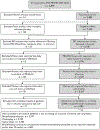Home care practices for preterm and term infants after hospital discharge in Massachusetts, 2007 to 2010
- PMID: 26248131
- PMCID: PMC11938103
- DOI: 10.1038/jp.2015.90
Home care practices for preterm and term infants after hospital discharge in Massachusetts, 2007 to 2010
Abstract
Objective: The objective of this study was to compare the prevalence of home care practices in very to moderately preterm (VPT), late preterm (LPT) and term infants born in Massachusetts.
Study design: Using 2007 to 2010 Massachusetts Pregnancy Risk Assessment Monitoring System data, births were categorized by gestational age (VPT: 23 to 33 weeks; LPT: 34 to 36 weeks; term: 37 to 42 weeks). Home care practices included breastfeeding initiation and continuation, and infant sleep practices (supine sleep position, sleeping in a crib, cosleeping in an adult bed). We developed multivariate models to examine the association of infant sleep practices and breastfeeding with preterm status, controlling for maternal sociodemographic characteristics.
Results: Supine sleep position was more prevalent among term infants compared with VPT and LPT infants (77.1%, 71.5%, 64.4%; P=0.02). In the adjusted model, LPT infants were less likely to be placed in supine sleep position compared with term infants (adjusted prevalence ratio=0.86; 95% confidence interval: 0.75 to 0.97). Breastfeeding initiation and continuation did not differ among preterm and term groups. Nearly 16% of VPT and 18% of LPT and term infants were not sleeping in cribs and 14% of LPT and term infants were cosleeping on an adult bed.
Conclusion: Compared with term infants, LPT infants were less likely to be placed in supine sleep position after hospital discharge. A significant percent of preterm and term infants were cosleeping on an adult bed. Hospitals may consider improving their safe sleep education, particularly to mothers of LPT infants.
Conflict of interest statement
CONFLICT OF INTEREST
The authors declare no conflict of interest.
Figures
References
-
- Hamilton BE, Martin JA, Ventura SJ. Births: final data for 2012. Natl Vital Stat Rep 2013; 62(3): 9. - PubMed
-
- Massachusetts Births 2010. Division of Research and Epidemiology, Bureau of Health Information, Statistics, Research, and Evaluation, Massachusetts Department of Public Health: Boston, MA, October 2012.
-
- Vernacchio L, Corwin MJ, Lesko SM, Vezina RM, Hunt CE, Hoffman HJ et al. Sleep position of low birth weight infants. Pediatrics 2003; 111(3): 633–640. - PubMed
-
- Hwang SS, Barfield WD, Smith RA, Morrow B, Shapiro-Mendoza CK, Prince CB et al. Discharge timing, outpatient follow-up, and home care of late-preterm and early-term infants. Pediatrics 2013; 132(1): 101–108. - PubMed
-
- Vohr BR, Poindexter BB, Dusick AM, McKinley LT, Wright LL, Langer JC et al. Beneficial effects of breast milk in the neonatal intensive care unit on the developmental outcome of extremely low birth weight infants at 18 months of age. Pediatrics 2006; 118(1): e115–e123. - PubMed
Publication types
MeSH terms
Grants and funding
LinkOut - more resources
Full Text Sources
Medical


